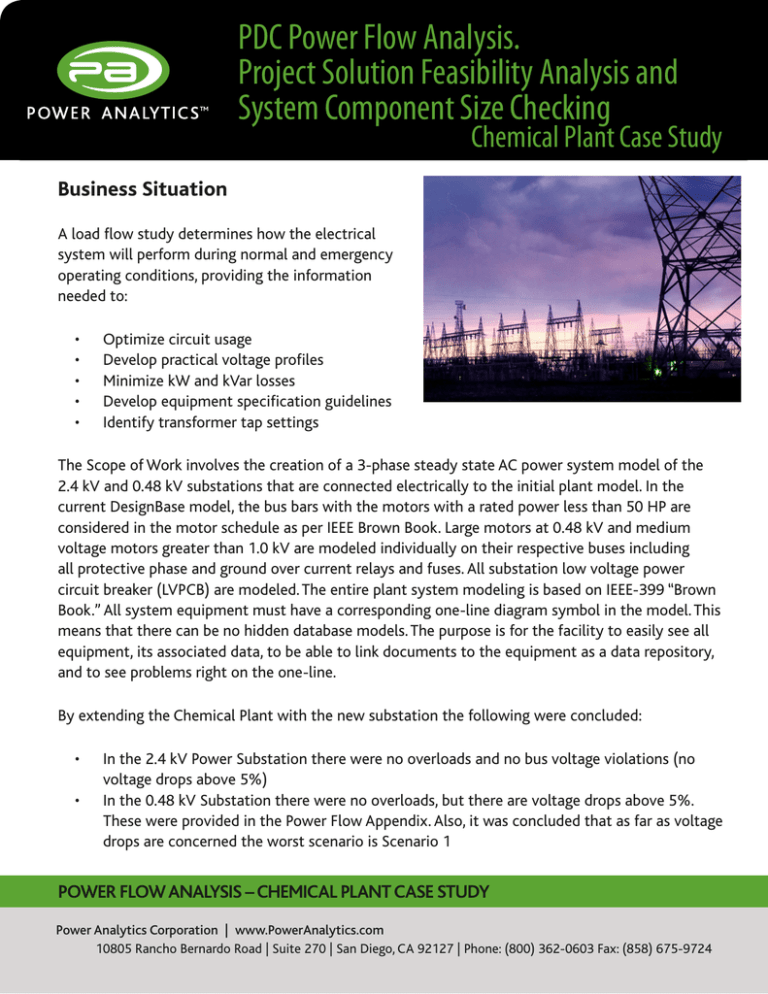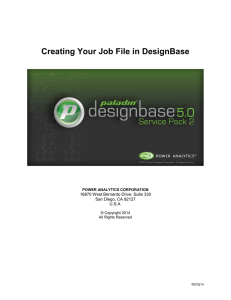
PDC Power Flow Analysis.
Project Solution Feasibility Analysis and
System Component Size Checking
Chemical Plant Case Study
Business Situation
A load flow study determines how the electrical
system will perform during normal and emergency
operating conditions, providing the information
needed to:
•
•
•
•
•
Optimize circuit usage
Develop practical voltage profiles
Minimize kW and kVar losses
Develop equipment specification guidelines
Identify transformer tap settings
The Scope of Work involves the creation of a 3-phase steady state AC power system model of the
2.4 kV and 0.48 kV substations that are connected electrically to the initial plant model. In the
current DesignBase model, the bus bars with the motors with a rated power less than 50 HP are
considered in the motor schedule as per IEEE Brown Book. Large motors at 0.48 kV and medium
voltage motors greater than 1.0 kV are modeled individually on their respective buses including
all protective phase and ground over current relays and fuses. All substation low voltage power
circuit breaker (LVPCB) are modeled. The entire plant system modeling is based on IEEE-399 “Brown
Book.” All system equipment must have a corresponding one-line diagram symbol in the model. This
means that there can be no hidden database models. The purpose is for the facility to easily see all
equipment, its associated data, to be able to link documents to the equipment as a data repository,
and to see problems right on the one-line.
By extending the Chemical Plant with the new substation the following were concluded:
•
•
In the 2.4 kV Power Substation there were no overloads and no bus voltage violations (no
voltage drops above 5%)
In the 0.48 kV Substation there were no overloads, but there are voltage drops above 5%.
These were provided in the Power Flow Appendix. Also, it was concluded that as far as voltage
drops are concerned the worst scenario is Scenario 1
Power Flow Analysis – Chemical Plant Case Study
Power Analytics Corporation | www.PowerAnalytics.com
10805 Rancho Bernardo Road | Suite 270 | San Diego, CA 92127 | Phone: (800) 362-0603 Fax: (858) 675-9724
Technical Situation
The Chemical Plant electrical distribution system is a complex network structure of electrical
components, operating at voltages: 69 kV, 2.4 kV, 0.48 kV, and 208. The network is constructed with
ring circuits but operates normally with radial feeds and normally open (NO) bus sections except
the incoming 69 kV circuits.
Solution
Paladin DesignBase software was used to perform the Power Flow Analysis. Today in power system
design a current procedure is “Simulation Based Design.” In the design process this approach allows
the user to check the correctness of the proposed solutions based on several simulated scenarios.
A Case Study is provided where DesignBase tools were used for assisting the design of a 2.4/0.480
kV substation interconnected to the existing plant power system. However, the substation is part of
a large Chemical Plant, and the system study was completed to determine the Bus Voltage Profile,
Branch Loading, and Short Circuit Level in the plant system network and evaluate the switching
and protective devices. Paladin DesignBase 4.0 software was used to complete the project. This
presentation focuses on Power Flow Analysis.
Paladin DesignBase 4.0 is state-of-the-art computer aided design and simulation software providing
real solutions to any electrical application. Based on the provided drawings and system data from
the client, the Paladin DesignBase model has been generated. The electrical system extension of the
Chemical Plant has been modeled as two separate models electrically interconnected to the existing
plant system model.
Bus IDs, branch names, and equipment characteristics are shown on the DesignBase model drawing
and project database. Equipment Naming has been input as per “One line diagrams provided by the
client.” However, in completing this model the plant drawings and data from plant engineers were
employed.
To insure compliance with IEEE Standards, no exceptions or substitutions to the performance
specification are allowed. The plant system model generated is made up of multiple model drawings
that are electrically interconnected. All one-line symbols are spaced properly to facilitate viewing
results on the one-line diagram while using back annotation.
Power Flow Analysis – Chemical Plant Case Study
PAGE 2
Power Analytics Corporation | www.PowerAnalytics.com
10805 Rancho Bernardo Road | Suite 270 | San Diego, CA 92127 | Phone: (800) 362-0603 Fax: (858) 675-9724
The following steps were implemented:
• Close communication with design engineers and contractors
• Getting the proposed design data:
−− System layout: one line connection diagram
−− Bus voltage magnitude and voltage phase at the substation PCC
−− Short circuit contribution at the substation PCC
−− Feeder data and length
−− XFMR type, manufacturer and XFMR data
−− Electrical motors data, location, motor switching equipment
−− Electrical loads, location, and estimated % running
• Based on the above input information, the substation model in DesignBase environment has
been generated
• Having a close communication with the client, 4 scenarios were implemented:
−− Both 2.4 kV and 0.48 kV tie CBs open
−− The 2.4 kV tie CB closed and 0.48 kV tie CB open
−− Both 2.4 kV and 0.48 kV tie CBs closed
−− The 2.4 kV tie CB open and 0.48 kV tie CB closed
Once the substation model was completed, Power Flow was run. One needs to understand that the
Power Flow convergence is the simplest way of checking if the given power system is feasible and
the input data are consistent. During the power flow, we should not have large bus voltage drops
(above 10%) and no more than 120% branch overloading. The main objectives of the Power Flow
studies are:
•
•
•
•
•
Verify that the input data for the system are consistent, and the system is feasible
Verify that the bus voltages are within the limits +/- 5%
Verify that the branches loading are within the limits, less than 80% loadings
Verify that the power transformers loading are within the limits, less than 80% loadings
Determine if the feeder sizes are correct
Power Flow Analysis – Chemical Plant Case Study
PAGE 3
Power Analytics Corporation | www.PowerAnalytics.com
10805 Rancho Bernardo Road | Suite 270 | San Diego, CA 92127 | Phone: (800) 362-0603 Fax: (858) 675-9724
Power Flow System Configuration and Scenarios
Power Flow study is performed at 40°C ambient temperature to provide conservative bus
voltage drop. The following configuration was considered in Power Flow (as per plant engineer
recommendations):
•
•
•
•
•
•
•
•
•
Generators are ON
Utility lines are ON
Available utility fault current is obtained from the model provided by the client
All HV and MV CB are closed
All LV CBs are closed, except the tie breakers that are normally open
The exceptions to the above are the CBs that are clearly marked in the model as future, out
of service, or for spare circuits, etc.
All motors are running
Tie breakers of all double-ended substations are open
Power Flow is run at 40°C ambient temperature
0.48 kV Power Substation:
Bus Voltage Violation - Visualization
Power Flow Analysis – Chemical Plant Case Study
PAGE 4
Power Analytics Corporation | www.PowerAnalytics.com
10805 Rancho Bernardo Road | Suite 270 | San Diego, CA 92127 | Phone: (800) 362-0603 Fax: (858) 675-9724
Benefits
Load flow studies are performed using computer software that simulates actual steady-state power
system operating conditions, enabling the evaluation of bus voltage profiles, real and reactive power flow,
and losses. Conducting a load flow study using multiple scenarios helps ensure that the power system
is adequately designed to satisfy your performance criteria. A properly designed system helps contain
initial capital investment and future operating costs. For this application, the power flow analysis
benefits include:
•
•
•
Decrease unexpected downtime
Reduce operating and maintenance costs
Get more capacity out of existing assets
Services Your Company Used
In order to provide the power flow analysis, Power Analytics used Paladin DesignBase software. The
software modules included:
Paladin DesignBase Power Flow Program
The Paladin® DesignBase™ Power Flow program is one of the most powerful, fast, and efficient
power flow programs ever developed. Equipped with an easy-to-use, intelligent graphical interface,
it supports advanced plotting, motor starting, and numerous options and modeling features.
The Power Flow program is based on advanced and robust solution algorithms that incorporate
state-of-the-art solution techniques applicable to large and complex power systems.
Results can be written directly on the one-line using the back annotation features, or all the
solution quantities (voltages and flows) are exportable to Microsoft Excel, and can be used to
customize reports using Professional Report Writer. Back annotation features can be enhanced by
using the coloring feature.
•
•
•
•
•
Generator local/remote bus voltage control
Four solution techniques: Newton-Raphson, fast de-coupled, hybrid solution, advanced Gauss
Seidel
Bus types can be defined as follows: “out of service,” “load,” “generator,” or “swing bus”
Multiple swing buses/co-generation units
Multiple independent islands
Power Flow Analysis – Chemical Plant Case Study
PAGE 5
Power Analytics Corporation | www.PowerAnalytics.com
10805 Rancho Bernardo Road | Suite 270 | San Diego, CA 92127 | Phone: (800) 362-0603 Fax: (858) 675-9724
•
•
•
•
•
•
•
•
•
•
•
Generator models can have different modes of operation: “fixed power output,” “fixed active
power and control voltage at the terminal or at a remote location”
Two- and three-winding voltage control transformer models
Transformers with fixed tap, voltage control, phase shifter (active power control), and
reactive power control
Transformers can be equipped with under load tap changers (ULTC) for local and remote bus
voltage control
SVC “static-var compensation” and shunt capacitor and reactors
“Area interchange control” allows many areas to participate in the area power interchange;
each area will have a dedicated generator for controlling the tie line power
DC lines and converter models
No bus-numbering limitations
Line voltage regulator (LVR)
Unlimited generators and/or motors schedules
Transformer sizing through ADPF simulation
About Power Analytics Corporation
Used by the power industry for more than 25 years, Power Analytics’ software solutions have surged
to the forefront of the electrical system planning, operation, and smart grid market space for use in
energy intensive, mission-critical facilities and microgrids. Paladin products currently protect more
than $100 billion in customer assets including financial data centers, air traffic control sites, military
installations, deep sea oil platforms, and power generation and distribution facilities. The company is
headquartered in San Diego, Calif., and has a smart grid center of excellence in Raleigh, N.C.
© Copyright 2013 Power Analytics Corporation. All rights reserved. Paladin, Power Analytics, Paladin
DesignBase, Paladin Live, Paladin SmartGrid, Paladin SmartGrid Power Management System, Paladin
Gateway, Paladin DesignView, Intelligence in Real Time, and Foresight as Accurate as Hindsight
and their associated logos and stylings, are pending or registered trademarks of Power Analytics
Corporation. All other trademarks, names, and logos are the property of their respective holders.
Power Analytics gratefully acknowledges governmental and regulatory agencies whose names,
photos, logos, award programs, or certification programs are listed herein; such use does not
constitute their endorsement of Power Analytics or its products by these agencies.
For more information on Power Analytics’ Paladin Software, visit www.PowerAnalytics.com.
Power Flow Analysis – Chemical Plant Case Study
PAGE 6
Power Analytics Corporation | www.PowerAnalytics.com
10805 Rancho Bernardo Road | Suite 270 | San Diego, CA 92127 | Phone: (800) 362-0603 Fax: (858) 675-9724



